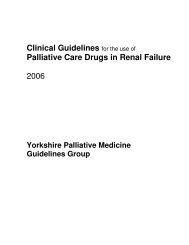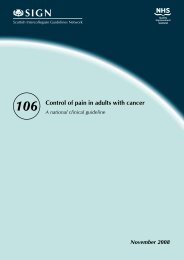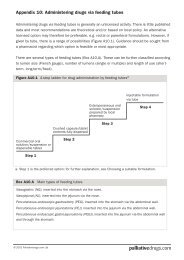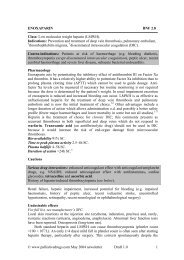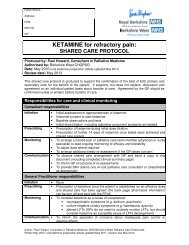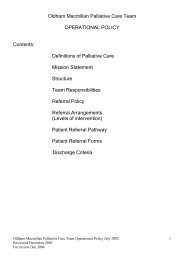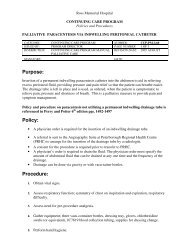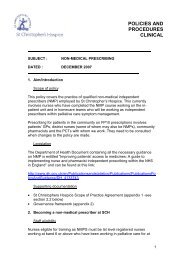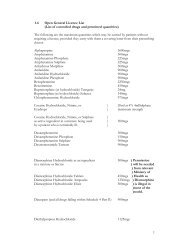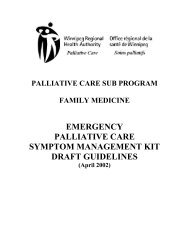Community Pharmacy Model Schemes for Pharmaceutical Care
Community Pharmacy Model Schemes for Pharmaceutical Care
Community Pharmacy Model Schemes for Pharmaceutical Care
You also want an ePaper? Increase the reach of your titles
YUMPU automatically turns print PDFs into web optimized ePapers that Google loves.
04/06/2003 FIONA MONTGOMERY MACMILLAN PALLIATIVE CARE PHARMACIST<br />
<strong>Community</strong> <strong>Pharmacy</strong> <strong>Model</strong> <strong>Schemes</strong> <strong>for</strong> <strong>Pharmaceutical</strong> <strong>Care</strong><br />
Palliative <strong>Care</strong><br />
1. Introduction<br />
The FVHB HIP acknowledges that the future development of palliative care in Forth<br />
Valley requires the Health Board to encourage multidisciplinary and multi-agency<br />
working. The HIP refers to reviewing existing palliative care pharmacy services;<br />
improving access to the range of equipment required; improving skills, knowledge and<br />
communication; and effective integration of cancer and palliative care services. The<br />
appointment of a Specialist Palliative <strong>Care</strong> Pharmacist <strong>for</strong> the Forth Valley Area has<br />
provided the means to manage continuity of pharmaceutical care across the primary and<br />
secondary care boundaries.<br />
The role of community pharmacists in contributing to this service has been<br />
acknowledged in the 1999-2000 remuneration settlement between the SPGC and the<br />
Scottish Executive. This earmarks money, from the global sum each year, to be used in<br />
developing community pharmacy networks targeting patients in the priority group areas<br />
of palliative care, frail elderly and those with severe and enduring mental illness. This<br />
scheme intends to address the needs of palliative care patients .<br />
2. Aim<br />
To establish a network of trained community pharmacists, based on Localities, providing<br />
a palliative care service to cancer patients in Forth Valley.<br />
3. Objectives<br />
♦ To ensure that patients requiring palliative care receive continuity of supply of<br />
essential medicines and devices <strong>for</strong> drug delivery.<br />
♦ To create a network of specialist community pharmacies to provide in<strong>for</strong>mation and<br />
advice on the pharmaceutical aspects of palliative care to patients ,carers, GPs nurses<br />
and other community pharmacists.<br />
4. Locality Palliative <strong>Care</strong> Pharmacists<br />
One community pharmacy from each Locality in Forth Valley will provide the service.
04/06/2003 FIONA MONTGOMERY MACMILLAN PALLIATIVE CARE PHARMACIST<br />
4.1 Selection Criteria<br />
♦ <strong>Pharmacy</strong> in each locality.<br />
♦ Evidence of and/or willingness to undertake further training in palliative care<br />
♦ Ability to provide continuity of service from each pharmacy<br />
♦ Willingness to participate in peer review.(quarterly)<br />
4.2 Responsibilities<br />
To ensure availability of drugs as listed in Appendix 2<br />
To participate in out of hours cover as specified in “Palliative <strong>Care</strong> Service Out of Hours<br />
and Unusual Drug Requests<br />
To provide support, advice and specialist drug stock (if required) to other community<br />
pharmacists in the locality.<br />
To work with GPs, District Nurses, and Macmillan Nurses in the locality, in meeting the<br />
needs of Palliative <strong>Care</strong> patients.<br />
To liaise with Acute and Primary <strong>Care</strong> Trust Pharmacists and Area Specialist Palliative<br />
<strong>Care</strong> Pharmacist to ensure seamless care when the patient is transferred between care<br />
settings.<br />
To maintain records of pharmaceutical care provided to each patient.<br />
4.3 Training<br />
Completion of SCPPE Palliative <strong>Care</strong> distance learning pack will <strong>for</strong>m the minimum<br />
level of training <strong>for</strong> Locality Palliative <strong>Care</strong> Pharmacists. The training needs of<br />
participating pharmacists will be assessed and relevant training provided.<br />
5. Responsibilities of Area Specialist Palliative <strong>Care</strong> Pharmacist<br />
To liaise with the APC and LHCC Pharmacists in the selection of locality palliative care<br />
pharmacists.<br />
To provide initial and ongoing training in palliative care to locality pharmacists (directly<br />
or indirectly).<br />
To provide support and advice to locality palliative care pharmacists.<br />
To facilitate liaison between primary and secondary care pharmacists.<br />
To monitor and audit the service.<br />
To organise regular peer review sessions (quarterly)
04/06/2003 FIONA MONTGOMERY MACMILLAN PALLIATIVE CARE PHARMACIST<br />
To ensure adequate in<strong>for</strong>mation/training <strong>for</strong> on call pharmacists in Acute Trust.<br />
6 Monitoring and Audit<br />
Quarterly statistics from network members. Number of patients “referred”, number of<br />
care issues identified, number of pharmacy contributions, items dispensed from specialist<br />
stock list<br />
Review stock list after 12 months and amend if necessary.<br />
<strong>Pharmacy</strong> contributions and outcomes to be documented and graded (? Nottingham<br />
System) at peer review and independently to give objective measure of contributions.<br />
7 Communication<br />
There is a need to ensure that all potential users of the network are aware of it’s existence<br />
and the community pharmacists involved.<br />
In<strong>for</strong>mation will need to be <strong>for</strong>warded to<br />
Acute Trust Pharmacists<br />
LHCC Pharmacists<br />
All <strong>Community</strong> Pharmacists FVHB<br />
Macmillan GP Facilitator<br />
All FVHB GP s<br />
All FVHB district and practice nurses<br />
All Macmillan Home <strong>Care</strong> Sisters (Strathcarron)- Potential to link Nurses to pharmacist<br />
in their area.<br />
Hospital Macmillan Nurses.<br />
Strathcarron Medical Staff (<strong>for</strong> in<strong>for</strong>mation )<br />
Local patient groups (general in<strong>for</strong>mation about network possibly to avoid directing<br />
patients or creating “invidious distinction”)<br />
8.3 Equipment: The model scheme includes access to drug delivery devices.This scheme<br />
should link into current mechanisms eg Joint Equipment Loan Store, Strathcarron<br />
Hospice (syringe drivers). This avoids the purchase or storage of equipment in<br />
community pharmacy premises and maximises the use of current stocks.



